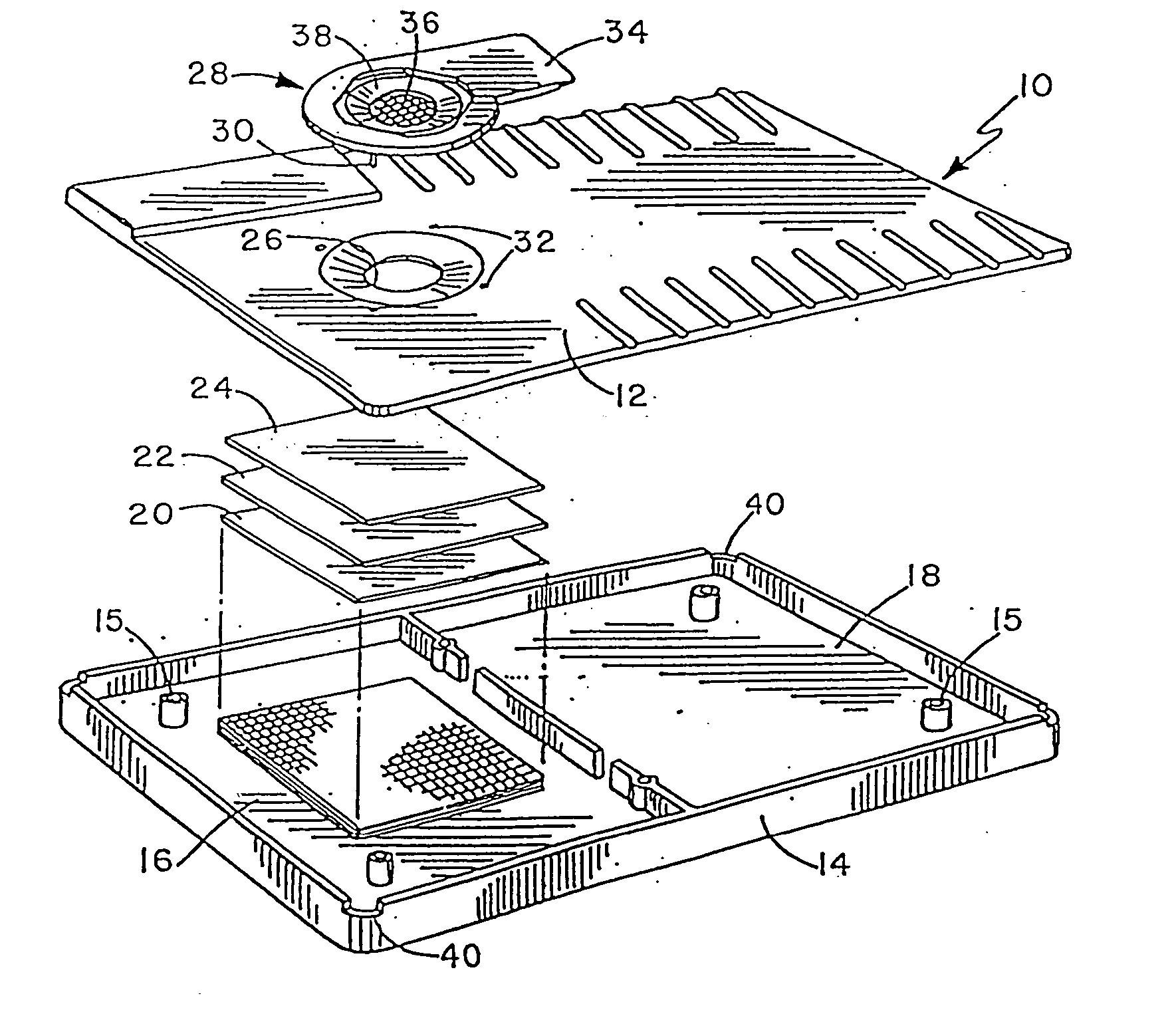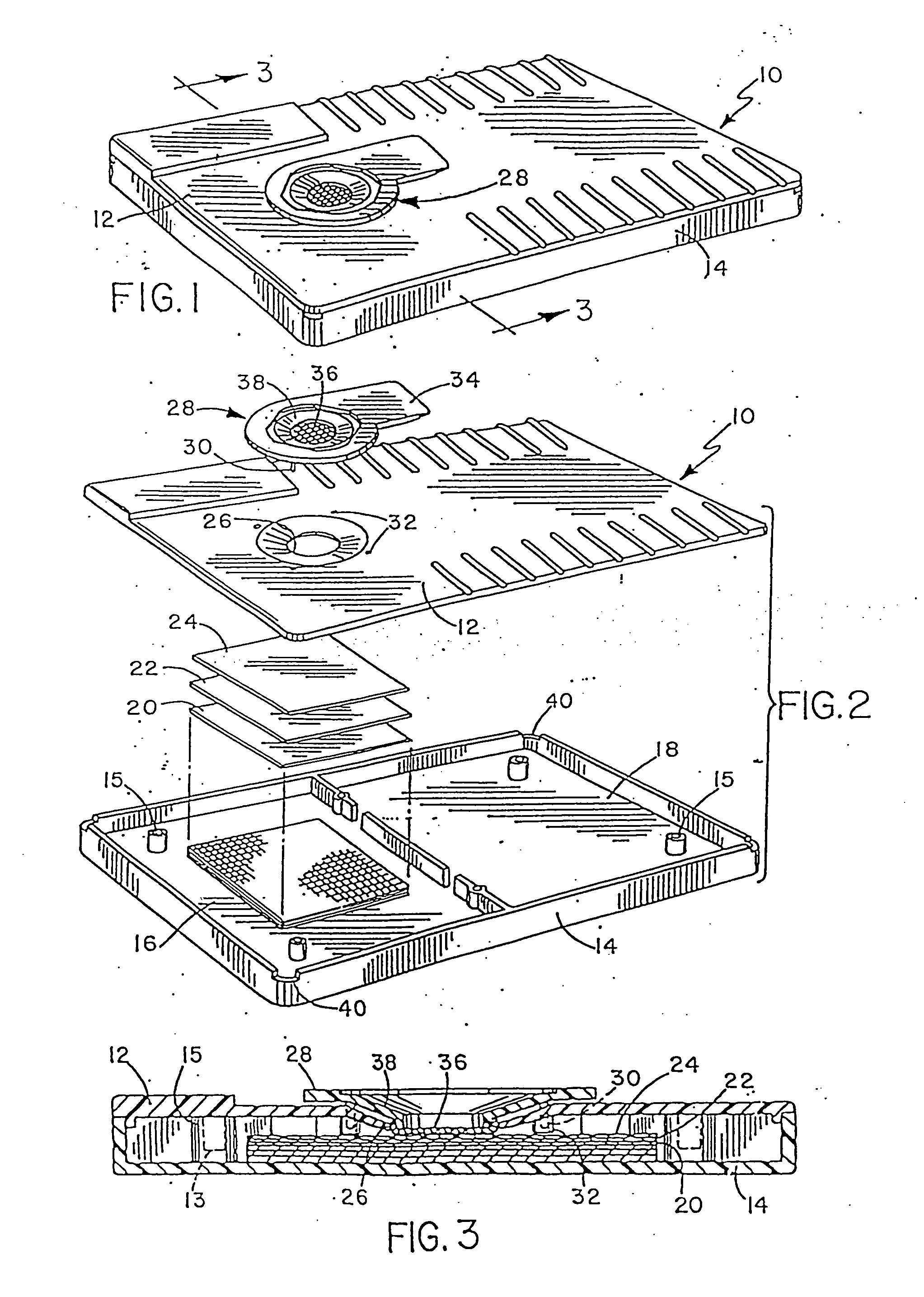Immunodiagnostic device having a desiccant incorporated therein
a desiccant and immunoodiagnostic technology, applied in the field of diagnostic assays, can solve the problems of reducing the sensitivity and reliability of the assay, and less stable, or not stable at all, so as to enhance the sensitivity and long-term room temperature stability of the assay, and maintain the stability of the blocking agen
- Summary
- Abstract
- Description
- Claims
- Application Information
AI Technical Summary
Benefits of technology
Problems solved by technology
Method used
Image
Examples
example 1
Detection of Chorionic Gonadotropin Hormone (bCG)
[0061] This example will be described with reference to FIGS. 1 and 2. An amount of urine corresponding to approximately 0.5 milliliters, and containing 25 mIU / ml hCG was applied to the filtering device 28. The urine contacts the filter material 36 of the filtering device 28, and passes through the filter material, carrying with it a protein blocking agent, milk protein, impregnated in the filter material 36. The filtrate containing the blocking agent passes through the aperture 26, present in the top 12 and contacts the matrix material 24. The matrix material 24 is impregnated with antibodies to human hCG. The matrix material was made of nylon, of a type well known and routinely used in the art.
[0062] Impregnation of the matrix material 24 was realized using a printer / coder machine as described in U.S. Pat. Nos. 3,281,860 and 4,121,222 by applying a narrow stream of fluid to the matrix material 24 containing mouse monoclonal antibo...
example 2
Room Temperature Stability
[0067] The materials and methods used in Example 1 can be similarly employed here. After storing a diagnostic device for one year at room temperature, it was successfully used to assay a sample containing 25 mIU / ml of hCG.
example 3
Antigen Impregnation of the Matrix Material
[0068] It will be apparent to those skilled in the art that the present diagnostic device is not limited to detecting antigens. It is equally possible to detect circulating antibodies present in the bodily fluids of a patient that has experienced a challenge to his immune system. This is done by attaching to the matrix material the antigen that is responsible for eliciting the immune response, and then assaying for the presence of antibody. This aspect of the diagnostic device is applicable, for example, in detecting, or monitoring auto-immune, or allergy sufferers.
[0069] To demonstrate this aspect of the invention inactivated rubella virus can be attached to the matrix material 24 shown in FIG. 2, using a printer coder machine described in Example 1. Subsequently, a solution containing anti-virus antibody to be detected is added to the filtering device 28 shown in FIG. 2, and flows through the filter material 36, thereby producing a filt...
PUM
| Property | Measurement | Unit |
|---|---|---|
| temperatures | aaaaa | aaaaa |
| time | aaaaa | aaaaa |
| electric field | aaaaa | aaaaa |
Abstract
Description
Claims
Application Information
 Login to View More
Login to View More - R&D
- Intellectual Property
- Life Sciences
- Materials
- Tech Scout
- Unparalleled Data Quality
- Higher Quality Content
- 60% Fewer Hallucinations
Browse by: Latest US Patents, China's latest patents, Technical Efficacy Thesaurus, Application Domain, Technology Topic, Popular Technical Reports.
© 2025 PatSnap. All rights reserved.Legal|Privacy policy|Modern Slavery Act Transparency Statement|Sitemap|About US| Contact US: help@patsnap.com


